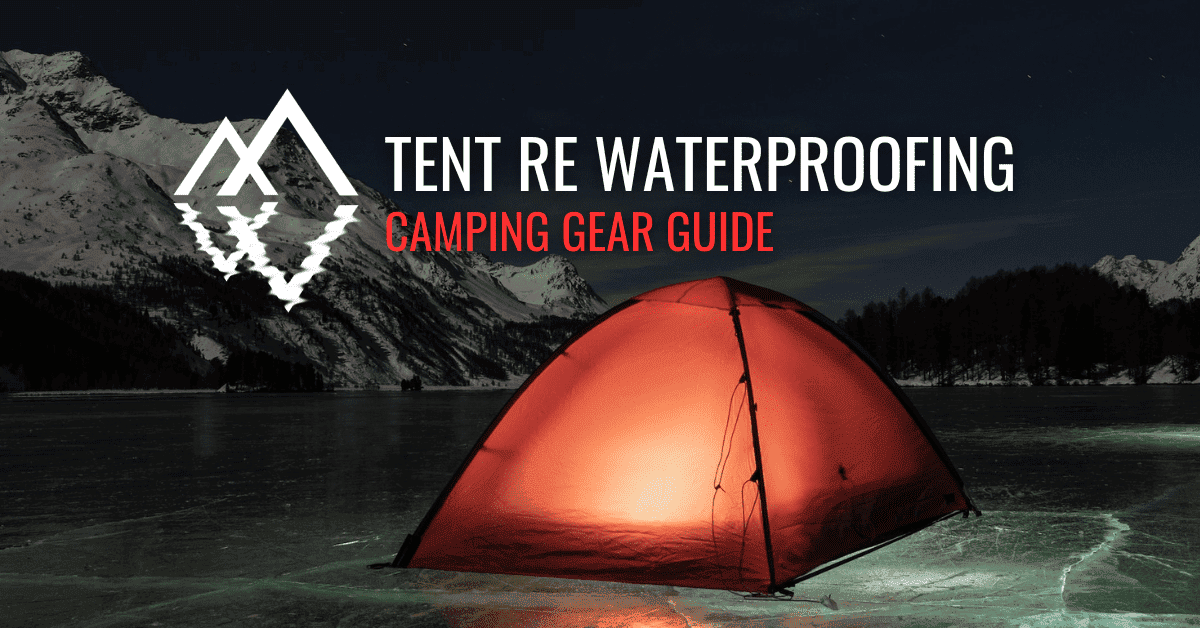Camping is one of the best ways to escape from the daily routine and experience nature. Owning a tent is an essential part of camping, as it provides a shelter from rain, wind, and other harsh weather conditions.
However, over time, tents can lose their waterproofing ability due to frequent use or exposure to the elements. When your tent loses its waterproofing ability, it becomes vulnerable to moisture penetration, which can cause discomfort or even damage your gear.
It’s essential to re-waterproof your tent regularly to prevent moisture from seeping into the fabric and causing problems such as mould growth or material degradation.
Tent re waterproofing will not only make it more comfortable during rainy weather but also prolong its lifespan.
Factors That Can Cause A Tent To Lose Its Waterproofing
First, let’s take a look at reasons why your tent may need re-waterproofing in the first place.
Various factors can contribute to the loss of waterproofing on a tent. One of the most common factors is frequent usage. When you use your tent frequently, especially in wet conditions like rain or snow, it weakens its waterproof coating over time.

Another factor that can cause a tent’s waterproof coating to deteriorate is environmental exposure. Exposure to ultraviolet (UV) radiation from the sun’s rays can break down a tent’s waterproof coating quickly.
Other elements like wind and dirt also contribute significantly over time. Washing your tent too frequently with harsh chemicals or detergents that are not designed for tents may also strip away its protective coatings faster than they should wear out naturally with regular usage.
Disclaimer: If you make a purchase via the links on our site, I may earn an affiliate commission at no additional cost to you. You can read my affiliate disclosure in the privacy policy. Thanks for your support!
Step 1: Assessing the Condition of Your Tent
Check for signs of wear and tear on the tent fabric
Before starting to re-waterproof your tent, it is essential to assess its current condition to determine if there are any areas that may need extra attention. The first step in assessing your tent is to check for signs of wear and tear on the fabric. Inspect the tent fabric for any visible holes, tears, or abrasions that could compromise its ability to keep water out.
Pay extra attention to high-stress areas such as corners, pole sleeves, and guy-out points. If you notice any damage during your inspection, it’s important to repair it before applying any waterproofing solution.
You can use a patch kit or sealant designed specifically for camping gear repairs. It is essential not to skip this step because waterproofing a damaged tent could worsen the problem by trapping moisture inside.
Inspect the seams, zippers, and other areas where water can seep in
The next step in assessing your tent’s condition is to inspect its seams, zippers, and other areas where water can seep in. These are usually the most vulnerable parts of a tent when it comes to keeping out moisture. Check all seams carefully for any gaps or loose threads that may have developed over time.
It’s crucial also to examine all zippers thoroughly because they are a common weak point in tents’ waterproofing systems. Over time dirt and grime can build up around zipper tracks and damage them so that they no longer zip tightly shut thus allowing water inside.
Look at vent openings and rainfly attachment points since these places if not properly sealed could be problematic during heavy downpours as they allow large amounts of water into your shelter space which will be uncomfortable. knowing how well your tent has held up after prolonged use ensures proper waterproofing application and repairs thus offering more time to enjoy the great outdoors.
Step 2: Choosing the Right Tent Re Waterproofing Product
Different Types of Waterproofing Products
When it comes to choosing a waterproofing product for your tent, there are several options available on the market. One of the most popular is silicone-based sprays or solutions.
These products create a durable, long-lasting barrier against water and can be applied to most materials without causing damage. Another option is polyurethane coatings, which provide excellent water resistance but can be tricky to apply and may require special equipment.
If you’re looking for a more environmentally-friendly option, there are also water-based treatments available that use non-toxic ingredients. These products are often biodegradable and safe for use around plants and animals.
Check out my top picks for the best tent waterproofing sprays here.
How to Choose a Product That is Compatible with Your Tent Fabric
When choosing a waterproofing product for your tent, it’s important to consider the type of fabric your tent is made from. Different materials require different types of treatments, so check your manufacturer’s instructions or do some research online before purchasing a product. For example, nylon tents should be treated with silicone-based sprays because they bond well with this material and won’t clog up pores in the fabric.
However, cotton canvas tents require a different type of sealant that can penetrate deep into the fibres and provide longer-lasting protection from moisture. If you’re unsure which product to use on your specific tent fabric, call up the manufacturer or consult with an outdoor gear expert who can advise you based on their experience.
Overall, choosing the right waterproofing product for your tent takes some research and careful consideration. Whether you opt for silicone sprays or polyurethane coatings depends largely on personal preference, but make sure to select a product that is compatible with your tent’s fabric and provides the level of water resistance you need for your next camping trip.
Step 3: Preparing Your Tent for Waterproofing
Clean your tent thoroughly before applying any waterproofing product
Before you start waterproofing your tent, it is important to clean it thoroughly. Dirt, dust, and grime can accumulate on the fabric over time and affect the effectiveness of the waterproofing spray.
Start by removing any loose dirt or debris using a soft-bristled brush or a damp cloth. Pay close attention to the areas around the zippers and seams where dirt tends to accumulate.
Next, fill a large bucket with warm water and add a mild detergent. Dip a sponge or cloth into the soapy water and gently scrub the tent fabric.
Avoid using harsh chemicals or abrasive cleaners as they can damage your tent’s coating. Rinse thoroughly with clean water and hang your tent out to dry.
Make sure that your tent is completely dry before applying any product
Before applying any waterproofing spray, make sure that your tent is completely dry. Even small amounts of moisture can affect how effectively the spray adheres to the fabric.
You can hang up your tent in a well-ventilated area until it is completely dry. If you are in a hurry, you can use an electric fan to speed up drying time.
Just be careful not to place it too close to your tent as this may cause damage or discoloration on parts of its material. Another option is to use a gentle heat source like sunlight or low heat from an electric heater if there’s no wind outside.
Check for damages before applying a waterproofing solution
It’s always important to check for damages such as tears, rips holes etc…, before applying any waterproof solution. If you detect any kind of damage on the fabric structure, make sure you repair them first using appropriate patches made for tent fabrics.
That being said, after completing these steps, you are ready to apply the waterproofing solution to your tent. By doing so, you will increase the longevity of your tent by ensuring that it is well-protected against moisture and harsh weather conditions.
Step 4: Applying Waterproofing Product to Your Tent
Evenly Applying Waterproofing Spray or Solution
Once you’ve chosen the right waterproofing product for your tent, it’s time to apply it. The first thing you should do is shake the spray can or bottle well before use.
Then, start spraying in a sweeping motion from one end of the tent to the other. Make sure to hold the can or bottle at least 6 inches away from the fabric and avoid over-spraying any one area.
If you’re using a waterproofing solution instead of a spray, use a brush or sponge to apply it evenly across the surface of your tent. Follow the directions on the product label for specific instructions on how much solution to use per square foot of fabric.
It’s important to work in small sections when applying waterproofing products so that you can ensure even coverage and avoid missing any spots. Continue spraying or applying until you’ve covered your entire tent.
Avoiding Over-Spraying or Under-Spraying Certain Areas
When applying waterproofing products, there are several areas that tend to be more vulnerable than others. These include seams, zippers and corners. To make sure these areas are properly coated, pay extra attention as you apply the product.
Be careful not to overspray any one area as this could cause pooling and uneven coverage. However, under-spraying may also leave some areas vulnerable and exposed.
One useful tip is to lay your tent flat on its back while spraying so that gravity works in your favour and helps distribute the product evenly across all surfaces. Pay special attention around zippers and seams by brushing extra solution into those areas with a soft-bristled brush.
Additional Tips
It’s important that you don’t miss any spots when applying waterproofer as even small, missed spots can leave your tent vulnerable to leaks. To ensure you don’t miss any areas, consider using a flashlight to highlight any holes or thinning spots. After applying the waterproofer product, let it sit for a few minutes before wiping away any excess with a clean cloth.
This helps to prevent pooling and ensures that the product is evenly distributed across all surfaces. Keep in mind that different waterproofing products have different drying times.
Be sure to refer to the label for specific instructions on how long your tent should dry for before packing it away. As a general rule, try to give your tent at least 24 hours to dry completely before packing it up.
Step 5: Drying and Curing Your Tent
Allow Your Tent to Dry Completely Before Packing It Away
Once you have applied the waterproofing product to your tent, it is crucial that you allow it to dry completely before packing it away. Any excess moisture can lead to mildew and mould growth, which can damage your tent over time.
The drying time will depend on the type of waterproofing product you use and the weather conditions in which you apply it. Typically, it takes 24-48 hours for a tent to dry completely.
To speed up the drying process, pitch your tent in a well-ventilated area where there is plenty of sunlight. Make sure that all areas of the tent are exposed to sunlight by opening all doors and windows.
You can also use a fan or dryer set on low heat to circulate air through your tent. However, avoid using high heat settings as they can damage the fabric of your tent.
How Long It Takes for Different Types of Waterproofing Products To Cure
Different types of waterproofing products have different drying times and curing periods. For example, silicone-based waterproofing sprays typically take longer to cure than water-based solutions.
Silicone sprays may take up to 72 hours or more before they completely cure and provide maximum water resistance. On the other hand, water-based solutions usually dry faster but require longer curing times before they become fully effective at repelling water.
Some products may require several days or even weeks before they achieve their maximum effectiveness. It’s important that you follow the manufacturer’s instructions regarding curing times for their specific product, as this will ensure that you get optimal results from your re-waterproofing efforts.
Caring for Your Newly Waterproofed Tent
To extend the life of your newly waterproofed tent, make sure that you store it properly when not in use. Always pack your tent away when it is completely dry to prevent mould and mildew growth.
Store your tent in a cool, dry place where it is protected from direct sunlight and moisture. Avoid folding or stuffing your tent haphazardly into its storage bag, as this can damage the fabric and seams over time.
Instead, fold your tent neatly and place it in its bag or a storage container that is big enough to accommodate it without compressing it too much. With proper care and maintenance, you can keep your tent waterproofed for many camping trips to come.

Additional Tips and Tricks
Keep Your Tent Dry
Once you have re-waterproofed your tent, it is crucial that you keep it dry. Water damage is one of the primary reasons why tents lose their waterproofing, so to prevent this from happening again, make sure to store your tent in a dry place.
If your tent becomes wet during a camping trip, take the time to dry it out before packing it away. You can hang it up or lay it out flat in the sun, but avoid folding or crumpling it while wet.
Regularly Inspect Your Tent
Even with proper care and maintenance, tents can still develop small holes or tears that can compromise their waterproofing abilities. Therefore, after every camping trip and before each use, make sure to inspect your tent for any signs of damage.
Check the zippers and seams for any loose threads or tears and repair them as soon as possible using a patch kit. Regular inspections will help catch problems early on before they become more significant issues.
Store Your Tent Properly
How you store your tent when not in use can also impact its lifespan and waterproofing abilities. Make sure to pack away clean and dry tents into their storage bag or container.
Avoid storing them in damp areas like basements or garages where mould could grow on them over time.
With these additional tips on maintaining your newly re-waterproofed tent, you can ensure that it remains durable for years to come. Remember to be diligent with upkeep by keeping it dry, regularly inspecting it for damages, repairing quickly when needed, and storing properly between uses – following these steps will help protect against any potential loss of waterproofing due to wear and tear over time!
Final Thoughts
Re-waterproofing your tent is a simple yet essential process that can make all the difference during your camping trip. By identifying the areas that need resealing, cleaning your tent, applying the waterproofing solution, letting it dry, and storing correctly you can ensure that your tent stays dry and comfortable in any weather conditions.
Ultimately by taking care of your tent and re-waterproofing it regularly, you can extend its lifespan and enjoy many more nights camping beneath the stars, comforted by the knowledge that your tent is waterproof and ready for adventure
Before you head out on your next camping trip, don’t forget to grab my free camping checklist to help you get organised before your next adventure.
Re Waterproofing a Tent FAQ
Can you make a tent waterproof again?
Yes, you can make a tent waterproof again by re-waterproofing it with a suitable waterproofing solution.
How often should you waterproof your tent?
The frequency of re-waterproofing your tent depends on various factors such as the type of tent, the frequency of use, and the camping conditions. As a general rule of thumb, it’s recommended to re-waterproof your tent once a year, especially if you use it frequently.
Do tents lose waterproofing over time?
Yes, tents can lose their waterproofing over time due to wear and tear, exposure to UV rays, and repeated use.
Is it worth waterproofing a tent?
Yes, waterproofing your tent is worth the effort as it can extend the lifespan of your tent, keep you dry and comfortable during camping trips, and prevent the growth of mold and mildew.
How do I keep the bottom of my tent from getting wet?
To keep the bottom of your tent from getting wet, use a groundsheet or footprint underneath your tent. This provides an extra layer of protection against moisture and prevents water from seeping through the ground.
What is the best thing to use to waterproof a tent?
There are different types of waterproofing solutions available, such as sprays, wash-ins, and paints. The best thing to use to waterproof your tent depends on the material of your tent and the camping conditions you’ll be facing. It’s important to choose a waterproofing solution that is suitable for your tent and read the instructions carefully before applying it.

About the Author
Steve Cleverdon is an adventure blogger dedicated to helping outdoor enthusiasts make the most of their outdoor experiences. With years of travel and many epic adventures including a 3000-kilometre solo hike across New Zealand, Steve has amassed practical knowledge on outdoor gear. You can learn more about his adventures here. Through expert reviews, recommendations, and guides, he equips his readers with the best gear for their next adventure. If you want to send Steve a quick message, visit his contact page here.




